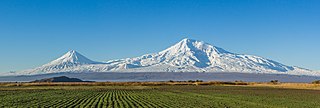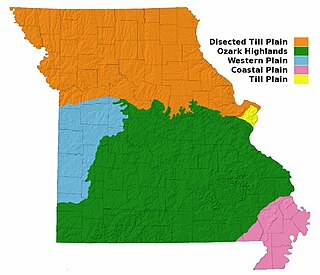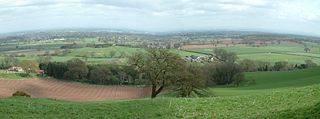
In geography, a plain is a flat, sweeping landmass that generally does not change much in elevation. Plains occur as lowlands along the bottoms of valleys or on the doorsteps of mountains, as coastal plains, and as plateaus or uplands.

Missouri, a state near the geographical center of the United States, has three distinct physiographic divisions:

The Harney Basin is an endorheic basin in southeastern Oregon in the United States at the northwestern corner of the Great Basin. One of the least populated areas of the contiguous United States, it is located largely in northern Harney County, bounded on the north and east by the Columbia Plateau—within which it is contained, physiographically speaking—and on the south and west by a volcanic plain. The basin encompasses an area of 1,490 square miles (3,859 km2) in the watershed of Malheur Lake and Harney Lake. Malheur Lake is a freshwater lake, while Harney Lake is saline-alkaline.

The South Plains is region in northwest Texas, consisting of 24 counties. The main crop is cotton.

Myakka River State Park is a Florida State Park, that is located nine miles (14 km) east of Interstate 75 in Sarasota County and a portion of southeastern Manatee County. The state park consists of 37,000 acres (150 km2), making it one of the state's largest parks. It is also one of the oldest parks in the state. It was delineated in the 1930s by the Civilian Conservation Corps. A small portion of the park was the gift of the family of Bertha Palmer to the state. The park is named after the Myakka River.
The Plano cultures is a name given by archaeologists to a group of disparate hunter-gatherer communities that occupied the Great Plains area of North America during the Paleo-Indian period in the United States and the Paleo-Indian or Archaic period in Canada.
The Cherohala Skyway is a 43-mile (69 km) National Scenic Byway and National Forest Scenic Byway that connects Tellico Plains, Tennessee, to Robbinsville, North Carolina in the southeastern United States. Its name is a portmanteau of Cherokee and Nantahala, the two national forests through which it passes. Along with multiple vistas and overlooks, the skyway provides easy vehicular access to various protected and recreational areas of the Unicoi Mountains, including the Citico Creek Wilderness, the Bald River Gorge Wilderness, and the remote interior of the Joyce Kilmer Memorial Forest.
Mill Creek Hundred is an unincorporated subdivision of New Castle County, Delaware. Hundreds were once used as a basis for representation in the Delaware General Assembly, and while their names still appear on all real estate transactions, they presently have no meaningful use or purpose except as a geographical point of reference.

Dutch Gap is located on Farrar's Island on the James River in Chesterfield County, Virginia; it was started as a canal by Union forces during the American Civil War to cut off a curl of the river known as Farrar's Island, which was controlled by Confederate forts. The canal was completed after the war and is now the main channel of the James River in this area. It is north of the lost 17th-century town of Henricus. Henricus Historical Park is devoted to that town.

Marvdasht is a city and the capital of Marvdasht County, Fars Province, Iran. At the 2006 census, its population was 123,858, in 29,134 families.

The term Cross Timbers, also known as Ecoregion 29, Central Oklahoma/Texas Plains, is used to describe a strip of land in the United States that runs from southeastern Kansas across Central Oklahoma to Central Texas. Made up of a mix of prairie, savanna, and woodland, it forms part of the boundary between the more heavily forested eastern country and the almost treeless Great Plains, and also marks the western habitat limit of many mammals and insects.

The Cheshire Plain is a relatively flat expanse of lowland almost entirely within the county of Cheshire in North West England. It extends from the Mersey Valley in the north to the Shropshire Hills in the south, bounded by the hills of North Wales to the west and the foothills of the Pennines to the north-east. The Wirral Peninsula lies to the north-west whilst the plain merges with the South Lancashire Plain in the embayment occupied by Manchester to the north. In detail, the plain comprises two areas with distinct characters, the one to the west of the Mid Cheshire Ridge and the other, larger part, to its east.

Reeds Gap State Park is a 220 acres (89 ha) Pennsylvania state park in Armagh Township, Mifflin County, Pennsylvania in the United States. The park is largely a wilderness area with large white pine and hemlock trees. Honey Creek flows through the park, providing a habitat for trout. Reeds Gap State Park is 7 miles (11 km) from U.S. Route 322 near Milroy in New Lancaster Valley and Bald Eagle State Forest.

The Geology of Pennsylvania consists of six distinct physiographic provinces, three of which are subdivided into different sections. Each province has its own economic advantages and geologic hazards and plays an important role in shaping everyday life in the state. They are: the Atlantic Coastal Plain Province, the Piedmont Province, the New England Province, the Ridge and Valley Province, the Appalachian Plateau Province, and the Central Lowlands Province.
Farm to Market Road 374 or FM 374 is a two-lane, state-maintained highway in the U.S. state of Texas that connects the farming areas of Cross Plains and Pioneer with State Highway 36 and State Highway 206. The highway continues from Cross Plains eastward through eastern Callahan County and connects in Eastland County with SH 36. After a 0.5-mile (0.8 km) gap at SH 36, FM 374 continues east to Pioneer, Texas.
The Goshen point is a medium-sized, lanceolate-shaped, Paleo-Indian projectile point with a straight or concave base. It exhibits characteristic fine flaking.
Hell Gap complex is a Plano culture from 10,060 to 9,600 before present. It is named after the Hell Gap archaeological site, in Goshen County, Wyoming.

Jarman Gap is a wind gap in the Blue Ridge Mountains in the counties of Albemarle and Augusta, Virginia.

The County of Daly is one of the 49 cadastral counties of South Australia. It was proclaimed in 1862 and named for Governor Dominick Daly. It covers the northern half of Yorke Peninsula stretching just east of the Hummock-Barunga Range in the west and just past the Broughton River in the north.

The gaps of the Allegheny, meaning gaps in the Allegheny Ridge in west-central Pennsylvania, is a series of escarpment eroding water gaps along the saddle between two higher barrier ridge-lines in the eastern face atop the Allegheny Ridge or Allegheny Front escarpment. The front extends south through Western Maryland and forms much of the border between Virginia and West Virginia, in part explaining the difference in cultures between those two post-civil war states. While not totally impenetrable to daring and energetic travelers on foot, passing the front outside of the water gaps with even sure footed mules was nearly impossible without navigating terrain where climbing was necessary on slopes even burros would find extremely difficult.
















